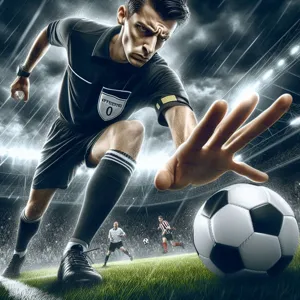Soccer, known as football in many parts of the world, is often hailed as the beautiful game, captivating millions with its thrilling plays and passionate fandom.
However, as the sport continues to evolve in an increasingly fast-paced and competitive landscape, a pressing question emerges: should we rethink the rules of soccer? From the implementation of video assistant referees (VAR) to debates surrounding player safety and the length of matches, discussions about reforming the game are gaining momentum. In this blog post, we will delve into the current state of soccer, exploring the arguments for and against potential rule changes. By examining how these adjustments could enhance the game’s integrity, accessibility, and excitement, we invite you to join us in envisioning a future where soccer remains not only a beloved pastime but also a dynamic and inclusive sport for generations to come.
1. Introduction: The Current Landscape of Soccer

Soccer, known as football outside of North America, stands as one of the most beloved and widely played sports in the world. With its rich history, spanning over a century, the beautiful game has captivated millions, uniting fans from diverse cultures and backgrounds under a common passion. From the roar of packed stadiums to the quiet thrill of a neighborhood match, soccer has a unique ability to transcend boundaries and bring people together, making it a cornerstone of global sports culture.
However, as we navigate the complexities of the modern era, the landscape of soccer is facing critical challenges that prompt a reevaluation of its rules and structure. The rapid evolution of technology, the influence of social media, and the increasing commercialization of the sport have altered the way fans engage with their favorite teams and players. Moreover, issues such as player welfare, fairness in competition, and the environmental impact of the sport are pressing topics that demand attention.
In this context, the effectiveness of existing rules is often called into question. Are they still serving the best interests of the game, or are they hindering its growth and enjoyment? As we delve into the current landscape of soccer, we must examine not only the traditional rules that have defined the sport but also the innovations and modifications that could enhance its future. This exploration is essential, for the heart of soccer lies not just in its past but also in its potential to adapt and thrive in an ever-changing world. With that in mind, let’s embark on a journey to rethink the rules of soccer and consider what changes could elevate this cherished game to new heights.
2. Historical Evolution of Soccer Rules
The history of soccer, or football as it is known in most parts of the world, is a fascinating journey that reflects the evolution of the game and the societies that have embraced it. The roots of soccer can be traced back over 2,000 years to ancient China, Greece, and Rome, where various forms of ball games were played. However, the modern game began to take shape in the 19th century in England, where the lack of standardized rules led to confusion and inconsistencies in play.
In 1863, the formation of the Football Association marked a pivotal moment in soccer history. This was when the foundational rules of the game, known as the Laws of the Game, were first established. These rules set the groundwork for how soccer is played today, including aspects such as the size of the pitch, the number of players, and the duration of the match. However, as the sport grew in popularity and spread across the globe, it underwent several amendments to adapt to different cultures and playing styles.
Throughout the years, significant changes have been made to the rules to enhance the flow of the game, increase safety, and improve fairness. For instance, the introduction of the offside rule was designed to prevent goal-hanging and encourage team play, while the implementation of yellow and red cards in the 1970s aimed to regulate player conduct more effectively. More recently, technologies like VAR (Video Assistant Referee) have been introduced to ensure that crucial decisions are made with greater accuracy.
As the game continues to evolve, one must consider whether these historical changes have always been for the better. Some argue that the core essence of soccer is being diluted by excessive regulation and technology, while others believe that these adaptations are necessary to keep the game relevant in a fast-paced, modern world. Exploring the historical evolution of soccer rules invites us to question the very foundation of the game and whether it’s time to rethink the rules once more to enhance the experience for players and fans alike.
3. Key Issues in Modern Soccer

As the beautiful game continues to evolve, many key issues in modern soccer are coming to the forefront, challenging the traditional notions of how the sport should be played and governed. One of the most pressing concerns is the increasing influence of technology on the game. The introduction of Video Assistant Referee (VAR) has sparked intense debate among players, coaches, and fans alike. While intended to enhance fairness, VAR’s implementation has drawn criticism due to its impact on the flow of the game and the subjective nature of some decisions. Fans have found themselves frustrated by extended stoppages and the ambiguity that sometimes surrounds offside calls or penalty decisions.
Another significant issue is the disparity in financial power among clubs, particularly between established giants and smaller teams. The rise of lucrative broadcasting deals and sponsorships has led to an escalating arms race for talent, leaving many clubs struggling to compete. This financial divide not only affects the integrity of competition but also diminishes the romance of the sport, as underdog stories become rarer. The European Super League debacle highlighted these tensions, leading to widespread backlash against a system that seemed to prioritize profit over sporting merit.
Moreover, the growing concern for player welfare has become a key topic in modern soccer discussions. The relentless pace of the game, coupled with congested fixture schedules, raises questions about the physical and mental health of players. Injuries are on the rise, and the demand for player rotation and recovery has never been more critical. As clubs juggle the demands of domestic leagues, cup competitions, and international duty, the need for a more balanced approach to scheduling and player care is paramount.
Finally, the sport’s relationship with social issues cannot be ignored. From racism to gender inequality, soccer has a unique platform to drive change, yet it often struggles to address these problems effectively. Players and fans are increasingly vocal about their expectations for the sport to take a stand, and governing bodies are under pressure to implement meaningful reforms.
In light of these key issues, the question of whether to change the rules of soccer becomes more relevant. Perhaps it’s time to rethink the very fabric of the game to ensure it remains fair, competitive, and inclusive for all. What changes could be made to preserve the essence of soccer while addressing these critical challenges? The conversation is just beginning.
4. Arguments for Changing the Rules
As the world of soccer continues to evolve, the debate around changing the rules of the game has gained traction among players, coaches, and fans alike. Proponents of rule changes argue that adaptations could lead to a more dynamic, engaging, and fair game. Here are some compelling arguments for reconsidering the established rules of soccer.
Firstly, one of the main critiques of the current rules revolves around the pace of the game. With the introduction of advanced technologies such as VAR (Video Assistant Referee), some suggest that the flow of play often gets interrupted, leading to a disjointed viewing experience. Advocates for change argue that implementing a shot clock, similar to that in basketball, could enhance the urgency of play and encourage teams to maintain an attacking mindset, ultimately resulting in a more thrilling spectacle for fans.
Additionally, the offside rule has long been a point of contention. Critics argue that it can stifle creativity and attacking play. By redefining or even abolishing the offside rule, the game could promote more goal-scoring opportunities, making matches more exciting and unpredictable. This change could also encourage more fluid play, enabling skillful players to shine without the constant threat of being flagged for offside.
Furthermore, the growing concern over player safety has prompted calls for stricter rules regarding physical contact and tackling. By implementing stricter penalties for dangerous tackles, the sport could prioritize players’ health, reducing the frequency of injuries and ensuring that the focus remains on skill rather than physicality. This shift could not only protect athletes but also lead to a more aesthetically pleasing game, where technical prowess takes precedence over brute strength.
Lastly, the inclusion of technology in officiating is becoming increasingly necessary in a fast-paced environment. Advocates suggest that expanding the use of technology, such as goal-line technology and real-time decision-making tools, could minimize human error and ensure fairness in officiating. This could foster greater trust in the game’s integrity and enhance the overall experience for both players and fans.
While change can be met with resistance, the arguments for evolving the rules of soccer highlight a desire for a more exciting, fair, and player-centric game. The future of soccer lies in its ability to adapt and grow, and as the sport continues to capture the hearts of millions, the conversation around rule changes may very well shape its next chapter.
5. Potential Rule Changes and Their Impacts

As we delve into the conversation about rethinking the game of soccer, it’s essential to explore potential rule changes and their impacts on both the sport itself and its devoted fanbase. While the traditional 90-minute match, two halves, and a singular ball have defined soccer for generations, innovative adjustments could redefine the way the game is played and experienced.
One popular suggestion is the introduction of a fourth substitution or the “sin bin” rule, similar to those in rugby. Allowing teams to temporarily replace a player for tactical reasons or to penalize fouls could increase strategic depth and keep the game flowing. This change might lead to a more dynamic and unpredictable match, keeping fans on the edge of their seats.
Another idea gaining traction is the implementation of video assistant referees (VAR) for every on-field decision. While VAR has faced criticism for interrupting the game’s rhythm, refining its use could enhance fairness and reduce controversial calls that often mar the outcome of crucial matches. Imagine a world where a crucial goal is celebrated without the nagging doubt of an offside call looming over the fans—a potentially exhilarating shift for supporters.
Additionally, considering adjustments to the offside rule could dramatically alter attacking play. By allowing players to position themselves closer to the goal, the game could see an increase in scoring opportunities and thrilling, fast-paced action. However, this change would require a delicate balance to maintain the integrity of defensive strategies and the essence of the game.
Lastly, rethinking extra time and penalty shootouts could also reshape the final moments of intense matches. By introducing a sudden-death format or allowing for alternative methods of determining the winner, such as a skills challenge, the climax of the game could become even more electrifying and engaging for fans.
Each of these proposed changes carries with it the potential to impact the essence of soccer—its strategy, its pace, and its very soul. As we contemplate these possibilities, it’s crucial to engage with players, coaches, and fans alike to gauge reactions and insights. The goal of any rule change should not only be to enhance the game but also to preserve the passion and tradition that have made soccer the beautiful game we know today.
6. The Role of Technology in Soccer
In an age where technology permeates every aspect of our lives, the beautiful game of soccer is no exception. The role of technology in soccer has evolved significantly over the years, transitioning from merely a support tool to a pivotal force that shapes the game’s dynamics. With innovations such as Video Assistant Referee (VAR), goal-line technology, and advanced analytics, the integration of tech has sparked passionate debates among players, coaches, and fans alike regarding its impact on the sport.
VAR, for instance, has introduced a layer of scrutiny that was previously unseen in soccer. By allowing referees to review contentious decisions, it aims to reduce the number of game-changing errors. However, while some applaud its ability to enhance fairness, others argue that it disrupts the fluidity and spontaneity that make soccer captivating. Fans often grapple with the long pauses in play, leading to frustrations that can overshadow the excitement of the match.
Goal-line technology, on the other hand, has been hailed as a success story. By utilizing high-speed cameras and sophisticated sensors, it provides instantaneous feedback on whether the ball has crossed the line, leaving no room for doubt. This innovation has added a layer of accuracy that enhances the integrity of the game, ensuring that clear-cut goals are recognized without the need for lengthy deliberations.
Beyond officiating, technology has also revolutionized the way teams prepare and strategize. Data analytics has become an essential aspect of modern soccer, allowing coaches to dissect player performances, assess opponents, and devise strategies based on statistical evidence. Wearable technology, such as GPS trackers and heart rate monitors, enables teams to monitor players’ physical conditions in real-time, optimizing training regimens and reducing the risk of injuries.
As we rethink the rules of soccer, it is crucial to consider the balance between tradition and innovation. While technology has the potential to enhance the game, it is essential to ensure that it complements rather than detracts from the core essence of soccer. The challenge lies in finding a harmonious integration that respects the sport’s rich history while embracing the advancements of the future. As the game continues to evolve, only time will tell how technology will redefine the beautiful game we all cherish.
7. Case Studies: Successful Rule Changes in Other Sports

When contemplating the evolution of soccer, it’s essential to look at how other sports have successfully adapted their rules to enhance gameplay and spectator engagement. These case studies provide a roadmap for potential changes in soccer, showcasing how thoughtful rule adjustments can lead to a more dynamic and exciting experience for players and fans alike.
One prime example is the introduction of the shot clock in basketball. Originally, teams could hold the ball indefinitely, leading to stagnant play and a lack of scoring. The implementation of a 24-second shot clock revolutionized the game, promoting a faster pace and more frequent scoring opportunities. This rule change not only increased excitement for fans but also encouraged teams to develop more strategic offensive plays, keeping both players and spectators on their toes.
Another compelling case can be found in American football, where the implementation of the two-point conversion in 1994 added a new layer of strategy to the game. After scoring a touchdown, teams now have the option to attempt a two-point conversion instead of kicking an extra point. This rule has fostered thrilling moments of tension and excitement, as teams must weigh the risks and rewards of their choices, ultimately leading to more engaging and unpredictable match outcomes.
In rugby, the introduction of the TMO (Television Match Official) has transformed how the game handles contentious decisions. The TMO allows for real-time video review of critical plays, ensuring that referees can make more accurate calls. This adjustment has increased the reliability of officiating and reduced post-game controversies, enhancing the overall enjoyment of the sport for both players and fans.
These examples illustrate that rule changes, when implemented thoughtfully, can breathe new life into a sport. By examining the successes of basketball, football, and rugby, soccer enthusiasts can draw inspiration and consider how similar adaptations could invigorate the beautiful game. Embracing change may unlock new dimensions of play, making soccer more captivating while still honoring its rich traditions.
8. Perspectives from Players and Coaches
When it comes to the beautiful game, the voices of those who live and breathe soccer—players and coaches—carry significant weight. Their insights not only reflect their experiences on the field but also illuminate the intricacies of the sport that spectators often overlook. Engaging with these key stakeholders offers a rich tapestry of opinions that can challenge the status quo and inspire innovative changes.
Players, with their firsthand experience of the game’s demands, often have unique perspectives on the rules that govern play. They understand the balance of strategy, skill, and physicality that makes soccer so compelling. Many express a desire for rules that enhance the fluidity of the game. For instance, some players advocate for a more lenient approach to fouls, arguing that allowing a bit more physicality could lead to a more dynamic and engaging match. Others call for the introduction of technology to aid referees, ensuring that the integrity of the game is upheld without disrupting its natural flow.
Coaches, on the other hand, approach these discussions with a strategic mindset. They analyze the rules not only from the player’s perspective but also through the lens of tactics and team dynamics. Many coaches argue for adjustments that could level the playing field, such as altering the offside rule to encourage more attacking play. The challenge, they say, is finding the right balance between maintaining the core essence of soccer while making it more accessible and enjoyable for both players and fans alike.
Additionally, there is a growing conversation around inclusivity in soccer, with both players and coaches advocating for rules that promote participation among diverse communities. This includes rethinking formats for games to accommodate different skill levels, thereby fostering a more inclusive environment that can attract new fans and players to the sport.
Ultimately, the perspectives of players and coaches are invaluable in the dialogue about reshaping soccer’s rules. By listening to those who experience the game at its most intimate levels, we can better understand how to preserve its integrity while also adapting to the evolving landscape of sports. Embracing these insights may not only enhance the game’s excitement but also ensure that soccer continues to thrive as a global phenomenon.
9. Fan Reactions: What Do Supporters Think?
When it comes to the beautiful game, the opinions of fans are as diverse as the teams they support. As discussions about changing the rules of soccer gain traction, the reactions from supporters are a mixture of anticipation, skepticism, and passion. Many fans express a deep-rooted connection to the traditions of the sport, valuing the historical context that shapes their love for soccer. For them, altering fundamental rules feels akin to tampering with the very essence of the game.
On social media platforms and fan forums, heated debates unfold as supporters share their thoughts. Some advocate for changes like introducing video technology to enhance officiating accuracy, while others argue that this disrupts the flow and spontaneity that make soccer thrilling. A common sentiment is the desire for balance; fans want to see improvements without sacrificing the integrity of the game they cherish.
Moreover, there is a significant segment of fans who embrace innovation, believing that rule changes could make the sport more exciting and accessible. They argue that implementing measures such as a shot clock or altering offside regulations could lead to higher-scoring games and more dynamic play. This group envisions a future where soccer remains relevant in an ever-evolving sports landscape, attracting new audiences and keeping younger fans engaged.
Whether through lively pub debates, social media threads, or fan polls, one thing is clear: the voice of supporters is crucial in this conversation. Their loyalty and passion drive the game forward, and any potential changes will inevitably be influenced by their reactions and preferences. As the world of soccer continues to evolve, the dialogue between fans, players, and officials will be key in determining the future of the rules that govern this beloved sport.
10. The Business Side: How Changes Could Affect Revenue
When contemplating changes to the rules of soccer, it’s essential to consider not just the game on the field but also the profound impact these alterations could have on the business side of the sport. Soccer is one of the most lucrative sports globally, generating billions in revenue through various streams such as ticket sales, broadcasting rights, merchandise, and sponsorships. Any shift in the rules could ripple through these financial channels, altering everything from game attendance to viewer engagement.
For instance, implementing a more dynamic scoring system or reducing match duration might attract a younger audience, invigorating interest and increasing ticket sales. However, such changes could also alienate traditional fans who cherish the depth and history of the game as it stands. This demographic shift could influence sponsorship deals, as brands often seek to align themselves with a stable, loyal fanbase.
Moreover, the broadcasting landscape would likely be affected. Networks invest heavily in acquiring rights to air matches, and any modifications to the game’s format could necessitate renegotiations or new approaches to coverage. Would a quicker game mean more ad space and higher revenues, or would it lead to a decrease in viewer retention?
Merchandising is another area ripe for consideration. Changes in team dynamics or player roles due to altered rules could spark new trends in merchandise sales, creating opportunities for brands to capitalize on. However, it could also mean that existing merchandise becomes outdated, leading to potential losses for clubs that have heavily invested in their current branding.
As we rethink the game, it’s vital to engage in a thorough analysis of how these changes might influence the financial ecosystem surrounding soccer. Stakeholders, from team owners to sponsors, must weigh the potential for increased revenue against the risks of disrupting a beloved sport. The balance between innovation and tradition will ultimately determine the long-term sustainability of any proposed changes and their impact on the business side of soccer.
11. Balancing Tradition and Innovation
In the world of soccer, tradition runs deep, woven into the very fabric of the game. From the iconic chants of passionate fans to the timeless rituals of matchdays, these elements create a rich tapestry that defines the sport. However, as we stand on the brink of a new era, the question arises: how can we embrace innovation without sacrificing the essence of what makes soccer special?
Balancing tradition and innovation requires a delicate touch. On one hand, there’s the allure of age-old customs—the elegance of a perfectly executed free kick, the thrill of a last-minute goal, and the camaraderie shared in the stands. These moments, steeped in history, evoke a sense of belonging and identity that resonates with millions around the globe. Yet, alongside this cherished heritage, the game faces pressing challenges: the increasing pace of play, the influence of technology, and the evolving expectations of fans.
Enter innovation, which offers exciting possibilities for enhancing the sport. From VAR (Video Assistant Referee) technology that seeks to minimize controversial calls to advanced analytics that help teams strategize more effectively, the potential for improvement is immense. Moreover, changes in rules—such as adopting a sin bin for yellow card offenses or experimenting with a new offside rule—could breathe fresh life into the game, making it more dynamic and engaging.
The key lies in finding that sweet spot where both worlds coexist. This could mean integrating technology to improve the fan experience while respecting the traditions that bring us together. For instance, as we consider potential changes to the offside rule, we must think about how those adjustments impact the flow of the game and the integrity of competition. Likewise, developing fan engagement strategies that blend modern digital platforms with the communal aspects of attending a match can enhance loyalty without losing the spirit of the sport.
Ultimately, the goal is to create a soccer landscape that honors its past while boldly stepping into the future. By fostering open discussions among players, fans, and stakeholders, we can navigate this complex terrain and shape a game that continues to captivate hearts for generations to come. Balancing tradition and innovation isn’t merely a choice; it’s a necessity for the evolution of soccer in a rapidly changing world.
12. The Future of Soccer: A Vision for Change
As we stand on the precipice of a new era in sports, it’s essential to envision a future for soccer that not only honors its rich history but also embraces the evolving landscape of athletics and fan engagement. The future of soccer should be characterized by innovation, inclusivity, and sustainability—three pillars that can redefine the beautiful game for generations to come.
Imagine a world where technology seamlessly integrates with gameplay. From enhanced VAR systems that ensure fairness to AI-driven analytics that provide real-time insights during matches, technology can elevate the spectator experience while preserving the integrity of the game. Imagine fans being able to interact with matches on a deeper level, utilizing augmented reality to view player statistics or engage in immersive experiences during live games. This tech-savvy approach could attract younger audiences and revitalize interest in the sport.
Inclusivity is another vital aspect of soccer’s future. Expanding outreach programs and grassroots initiatives can ensure that the game is accessible to all, regardless of age, gender, or socio-economic background. By investing in women’s leagues, adaptive sports, and community-based programs, soccer can foster a diverse player base that reflects the global population. This inclusivity not only strengthens the sport but also promotes unity and understanding among different cultures.
Sustainability must also take center stage as we look ahead. From eco-friendly stadiums to initiatives aimed at reducing the carbon footprint of international tournaments, soccer has a unique opportunity to lead by example in environmental stewardship. Imagine stadiums powered by renewable energy, or clubs that contribute to local environmental projects. By prioritizing sustainability, soccer can demonstrate its commitment to the planet and inspire fans to engage in responsible practices.
In this envisioned future, soccer transcends the field, becoming a catalyst for social change and a beacon of hope. By rethinking the rules and embracing innovation, inclusivity, and sustainability, we can create a game that not only thrives but also uplifts communities worldwide. It’s time to start a dialogue about the future of soccer—a future where the game continues to grow, inspire, and unite us all.
13. Conclusion: Finding a Middle Ground
In contemplating whether to change the rules of soccer, it’s essential to consider a path that honors the sport’s storied history while embracing the evolving needs of modern play. The game has been a source of passion and unity for millions around the globe, and any alterations must be approached with care and respect for its traditions.
Finding a middle ground means engaging diverse voices from players, coaches, fans, and officials. It requires a collective dialogue that weighs the merits of innovation against the cherished aspects of the game. Perhaps we could explore adjustments that enhance player safety without compromising the game’s integrity, or introduce technology to assist referees while maintaining the human element of officiating.
Additionally, we must consider the impact of any rule changes on different levels of play, from grassroots to professional leagues. The essence of soccer lies not only in its competitive spirit but also in its accessibility. Any modifications should promote inclusivity, ensuring that the game remains a platform for community engagement and global connection.
Ultimately, the goal is to preserve the heart of soccer while adapting to the realities of contemporary sports culture. It’s about crafting a vision for the future that respects the past—a vision where the beautiful game continues to thrive and inspire generations to come. As we stand at this crossroads, the discussion opens up exciting possibilities for the evolution of a beloved sport, inviting us to think creatively while staying rooted in what makes soccer truly special.
14. Call to Action: Engaging Fans in the Discussion
As we navigate the evolving landscape of soccer, it’s crucial to remember that the heart of the game lies not just in the players on the field but also in the passionate fans who support them. This is your moment to be a part of the conversation. We invite you, the fans, to share your thoughts, insights, and visions for the future of soccer. What changes do you believe could enhance the game? Are there specific rules you think need revisiting, or perhaps new formats that could invigorate the sport?
Engaging in this discussion can take many forms. Join us on social media platforms using the hashtag #RethinkSoccerRules to connect with fellow enthusiasts. Share your ideas in comments, videos, or even artwork that captures your vision of a reimagined game. Consider participating in local forums or soccer clubs that welcome discussions on rule changes, fostering a grassroots movement that could catch the attention of the larger soccer community.
As we collectively brainstorm and debate, let’s remember that every great change in the world of sports often begins with the voices of its most dedicated supporters. Together, we can influence the future of soccer, turning our dreams for the game into a reality. Your input matters—let’s make sure it’s heard!
15. Resources for Further Reading on Soccer Reform
If you’re intrigued by the idea of rethinking soccer’s rules and exploring potential reforms, there’s a wealth of resources available to deepen your understanding and spark thoughtful discussions. Here are some key materials that can guide you through the complexities of soccer reform and inspire new perspectives on the beautiful game:
1. **Books**: Dive into titles like “How Soccer Explains the World” by Franklin Foer, which examines the cultural impact of the sport across various nations. For a more analytical approach, “The Soccer War” by Ryszard Kapuściński provides insight into how the sport intersects with politics and society.
2. **Research Papers**: Explore academic journals that focus on sports management, sociology, and economics. Papers on the implications of rule changes or the impact of technology in soccer can provide a scholarly backdrop to your understanding of the game’s evolution.
3. **documentaries**: Engage with documentaries such as “Take the Ball, Pass the Ball,” which delves into the philosophy and tactics of modern soccer, or “Sunderland ‘Til I Die,” offering an in-depth look at the emotional and financial stakes involved in club soccer. These films can highlight the human side of the sport while also addressing the need for reform.
4. **Podcasts**: Tune into soccer-focused podcasts like “The Football Ramble” or “The Total Soccer Show,” where hosts discuss current events, rule changes, and the future of the sport. These conversations often feature expert opinions and can introduce you to new ideas regarding potential reforms.
5. **Websites and Blogs**: Follow dedicated soccer analysis blogs such as “Zonal Marking” or “The Tactical Times,” which break down strategies, rules, and player performances. Many of these platforms also engage in discussions around necessary changes in the sport, making them a valuable resource for reform-minded fans.
6. **Fan Forums and Social Media Groups**: Joining online communities can provide an avenue for discussion and debate about soccer reform. Platforms like Reddit have dedicated subreddits where fans share their thoughts on rule changes, and you can engage with a global audience to gather diverse insights.
By exploring these resources, you’ll gain a richer understanding of the potential pathways for reforming soccer. Whether you’re a lifelong fan or new to the sport, these materials will equip you with the knowledge to engage in meaningful conversations about the future of soccer. After all, the game is indeed evolving, and informed voices can play a crucial role in shaping its next chapter.
As we conclude our exploration of whether it’s time to rethink the game of soccer, it’s clear that the conversation surrounding rule changes is both complex and essential for the evolution of this beloved sport. From enhancing player safety to making the game more engaging for fans, the potential for change offers exciting possibilities while also challenging traditions that have shaped soccer for centuries. Whether we advocate for incremental adjustments or a bold overhaul, one thing remains certain: our passion for the game is what drives these discussions. We invite you to join the conversation—share your thoughts on potential rule changes and how they could impact the future of soccer. After all, the beautiful game is a reflection of our collective love for it, and together, we can ensure it continues to thrive in a way that resonates with both players and fans alike.






